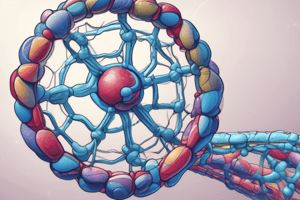Podcast
Questions and Answers
Quale gruppo de macromoleculas contene amino acidos?
Quale gruppo de macromoleculas contene amino acidos?
- Polisacaridos
- Lipidos
- Nucleotidos
- Proteinas (correct)
Quale descricao corresponde a un amino acido zwitterion?
Quale descricao corresponde a un amino acido zwitterion?
- Es formate de β-amino acidos.
- Es in solido forma sempre.
- Contine grupos amino e carboxylo con neutralitate overall. (correct)
- Contine solmente carbon e hydrogene.
Que determina le characteristicas chimic de un amino acido?
Que determina le characteristicas chimic de un amino acido?
- La sequence de nucleotidos.
- Le tipo de legamines interatomicos.
- Le grupo R attachate al carbono α. (correct)
- Le numero de carbonos in le cadena principale.
Que caracteristica define un amino acid α-amino?
Que caracteristica define un amino acid α-amino?
Quale de illos non este un monomero de un biomolecule?
Quale de illos non este un monomero de un biomolecule?
Quale de le sequentes combinationes de moleculas es un macromolecula biologic?
Quale de le sequentes combinationes de moleculas es un macromolecula biologic?
Quantos amino acidos es conosce in natura, e quantos es usate in le codice genetic?
Quantos amino acidos es conosce in natura, e quantos es usate in le codice genetic?
Que es le function principale de nucleic acids?
Que es le function principale de nucleic acids?
Quale estructura de proteina es definite per le sequenza de amino acidos?
Quale estructura de proteina es definite per le sequenza de amino acidos?
Quid determina le structura de un proteina?
Quid determina le structura de un proteina?
Quale de iste opzioni describe le structura terciaria de un proteina?
Quale de iste opzioni describe le structura terciaria de un proteina?
Quale opzione non es un function typic de proteinas?
Quale opzione non es un function typic de proteinas?
Quale de iste amino acidos es classify comme basico?
Quale de iste amino acidos es classify comme basico?
Quid es un motifa pro un proteina?
Quid es un motifa pro un proteina?
Quale statement es ver pro le structura quaternaria?
Quale statement es ver pro le structura quaternaria?
Quid causa le folding de un proteina?
Quid causa le folding de un proteina?
Quid determina le function de un proteina?
Quid determina le function de un proteina?
Quale protein structure es considerate le base del polypeptide?
Quale protein structure es considerate le base del polypeptide?
Quale de le sequente amino acidos es polar?
Quale de le sequente amino acidos es polar?
Un dimer es definite como:
Un dimer es definite como:
Le legame entre amino acidos es a vices per quelle bonds?
Le legame entre amino acidos es a vices per quelle bonds?
Flashcards
Amino acid
Amino acid
Molecula organica con un gruppo amino e un gruppo acido carboxilico.
Proteina
Proteina
Macromolecula biologica composta per una o plu catena de aminoacidos ligata per legami peptidici.
Sequenza aminoacidica
Sequenza aminoacidica
Ordine de aminoacidos in un catena peptidica.
Struttura primaria
Struttura primaria
Signup and view all the flashcards
Struttura secondaria
Struttura secondaria
Signup and view all the flashcards
Struttura terziaria
Struttura terziaria
Signup and view all the flashcards
Struttura quaternaria
Struttura quaternaria
Signup and view all the flashcards
Dominio
Dominio
Signup and view all the flashcards
Motivo
Motivo
Signup and view all the flashcards
Functiona de la proteina
Functiona de la proteina
Signup and view all the flashcards
Macromolecules
Macromolecules
Signup and view all the flashcards
Monomers
Monomers
Signup and view all the flashcards
Polymers
Polymers
Signup and view all the flashcards
Condensation
Condensation
Signup and view all the flashcards
Hydrolysis
Hydrolysis
Signup and view all the flashcards
Polysaccharides
Polysaccharides
Signup and view all the flashcards
Lipids
Lipids
Signup and view all the flashcards
Proteins
Proteins
Signup and view all the flashcards
Nucleic acids
Nucleic acids
Signup and view all the flashcards
Amino acids
Amino acids
Signup and view all the flashcards
Zwitterion
Zwitterion
Signup and view all the flashcards
α-amino acids
α-amino acids
Signup and view all the flashcards
Genetic information
Genetic information
Signup and view all the flashcards
Genome
Genome
Signup and view all the flashcards
Chromosome
Chromosome
Signup and view all the flashcards
Operon
Operon
Signup and view all the flashcards
Study Notes
Molecular Biology Course Contents
- Macromolecules: Structure and function of DNA, RNA, and protein.
- Genetic Information: Genome, chromosome, operon, gene, and codon.
- Genetic Material: Viral genome, prokaryotic genome, and eukaryotic genome.
- Flow of Genetic Information: DNA and RNA replication, gene expression (transcription, RNA maturation, translation, post-translational modifications, and regulation).
- Cell Division: In prokaryotes and eukaryotes.
- Biological Macromolecules: Polymers (macromolecules) like polysaccharides, lipids, proteins, and nucleic acids are composed of monomers (subunits) such as simple sugars, fatty acids, amino acids, and nucleotides. Condensation reactions create polymers by linking monomers, and hydrolysis reactions break polymers down.
- Protein Classification of Amino Acids: Amino acids are the building blocks of proteins, and approximately 500 amino acids are known. Only 20 amino acids are used in coding genetic information. They behave as zwitterions in solution. They are classified based on their properties. alpha-amino acids and beta-amino acids. Beta-amino acids are not found in ribosomally synthesized proteins. Each amino acid has an R group attached to a central alpha-carbon, and this R group determines the amino acid's unique chemical properties.
- Protein Structure: Primary structure is the sequence of amino acids in a polypeptide chain. The polypeptide chain has a carboxyl terminus (C-terminus) and an amino terminus (N-terminus). Secondary structure includes alpha-helices and beta-sheets, which are formed by hydrogen bonds between amino acid backbones. Tertiary structure describes the overall three-dimensional shape of the protein. This shape is determined by interactions between the amino acid side chains (R-groups). Quaternary structure occurs when two or more polypeptide chains interact to form a larger protein complex.
- Protein Domains, Motifs, and Functions: Domains in proteins are semi-independent parts with functional units within proteins. Motifs are repeated structural elements or amino acid combinations. Proteins have diversified functions, including enzymatic activities, signal reception, transport, storage, structural support, nutritional roles, immune response regulation, and regulatory activities. Examples of protein functions include enzymes like RUBISCO, signal receptors like rhodopsin, transport proteins like hemoglobin, and structural proteins like actin and myosin. Proteins like insulin and immunological proteins also fulfill hormonal and protective roles.
- Conjugated Molecules: Glycoproteins, glycolipids, lipoproteins, and nucleoproteins are examples of larger structures formed by joining proteins to other biomolecules like carbohydrates, lipids, or nucleic acids.
Studying That Suits You
Use AI to generate personalized quizzes and flashcards to suit your learning preferences.





